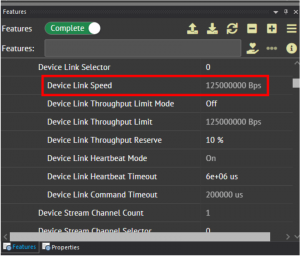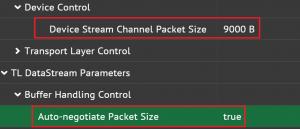If you're having trouble reaching the maximum frame rate, try the steps below.

1) Enable Jumbo Frames
LUCID Vision Labs recommends enabling jumbo frames on your Ethernet adapter. A jumbo frame is an Ethernet frame that is larger than 1500 bytes. Most Ethernet adapters support jumbo frames, however it is usually turned off by default.
The following table are some of the Ethernet adapters that LUCID Vision Labs has tested:
| Product Name | Maximum Jumbo Frame Size |
|---|---|
| ADLINK PCIe-GIE64+ | 9000 |
| ADLINK PCIe-GIE72/74 | 9000 |
| Neousys PCIe-PoE354at | 9500 |
| Intel EXPI9301CT (non-POE) | 9000 |
| IOI GE10-PCIE4XG202P | 9000 |
| IOI GE10P-PCIE4XG301 | 16000 |
Enabling jumbo frames on the Ethernet adapter allows a packet size of up to 9000 bytes. The larger packet size will enable optimal performance on high-bandwidth cameras, and it usually reduces CPU load on the host system. Please note in order to set a 9000 byte packet size on the camera, the Ethernet adapter must support a jumbo frame size of 9000 bytes or higher.
2) Increase Receive Buffers
A receive buffer is the size of system memory that can be used by the Ethernet adapter to receive packets. Some Ethernet adapter drivers or the operating system itself may set the receive buffer value to a low value by default, which may result in decreased performance. Increasing the receive buffer size, however, will also result in increased system memory usage.
3) Set Speed & Duplex to Auto Negotiation
In some scenarios it is possible that your camera enumerates at a lower link speed with your Ethernet interface card (for example, 100Mbps instead of 1000Mbps) due to lower speed setting on your Ethernet interface card. This can cap your frame rate at a much lower speed than the stated maximum frame rate of the camera. Your interface card should be able to negotiate up to the maximum speed connection. Alternatively you can manually set it to the maximum link speed (for example 1.0 Gbps Full Duplex for 1 GigE cards).
4) Enable Interrupt Moderation, Set Interrupt Moderation Rate to Adaptive
Interrupt Moderation allows your computer to interrupt the system to manage incoming and outgoing packets. The moderation rate determines how often this happens. A high moderation rate yields higher system performance at the cost of slower packet handling, while a low moderation rate yields faster packet handling at the cost of system performance. Setting Interrupt Moderation Rate to Adaptive allows the system to decide what rate to use given current circumstances.
5) Set ADC to 8-bit (Atlas cameras only)
Our stated maximum frame rates for Atlas models are based on 8-bit ADC setting. If your Atlas camera’s ADC is set to 10-bit or 12-bit your maximum frame rate will be lower as more data is sent per frame. If higher ADC bit depth is not needed, please set it to 8-bit to reach higher frame rates. Please note that Phoenix and Triton cameras only run at 12-bit ADC.
6) Check Device Link Speed in ArenaView
Once you have applied the setting changes, power cycle your camera and check the Device Link Speed node in ArenaView.

This shows the connection speed of the camera. You should see the following values for Device Link Speed:
- 1G cameras: 125000000 Bps (six zeros) as pictured
- 5G cameras: 625000000 Bps
- 10G cameras: 1250000000 Bps
If your Device Link Speed matches the expected value for your camera, this will allow you to achieve the highest possible frame rate.
7) Check Device Stream Channel Packet Size in ArenaView
To ensure the packet size is set to 9000 Bytes, make sure Stream Auto Negotiate Packet Size is set to true and check Device Stream Channel Packet Size is 9000 B when streaming.

The above settings will allow users to achieve a high framerate while reserving some bandwidth for packet resend. The above settings are the recommended settings for most use cases.
Achieving Maximum Possible Framerate
The steps below will show how to achieve the highest possible framerate on the camera.
1) Set Device Link Throughput Reserve to 0%

Device Link Throughput Reserve: Allocates the maximum percentage of bandwidth reserved for re-transmissions.
2) Set Stream Channel Packet Delay to 0

Stream Channel Packet Delay: Controls the delay (in GEV timestamp counter unit) to insert between each packet for this stream channel.